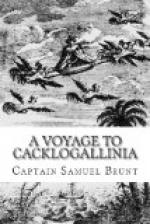Fortunately the authorship of the work is of little importance. It lives, not because of anything remarkable in the style or anything original in its author’s point of view, but because of its satiric reflection of the background of its age. It is republished both because of its historical value and because of its peculiarly contemporary appeal today. Its satire needs no learned paraphernalia of footnotes; it can be readily understood and appreciated by readers in an age dominated on the one hand by economics and on the other, by science. Its satire— not too subtle—is as pertinent in our own period as it was two hundred years ago. Its irony is concerned with stock exchanges and feverish speculation. It is a tale of incredible inflation and abrupt and devastating depression. Its “voyage to the moon” has not lost its appeal to men and women who can still remember a period when human flights seemed incredible and who have lived to see “flying chariots” spanning oceans and continents and ascending into the stratosphere.
The first and most obvious interest of the tale is in its reflection of economic conditions in the early eighteenth century. The period following the Revolution of 1688 saw tremendous changes in attitudes toward credit and speculation. A new and powerful economic instrument was put into the hands of men who had not yet discovered its dangers. With the natural confusion which ensued between “credit” and “wealth,” with a new emphasis upon the possible values inherent in “expectations of wealth” rather than immediate control over money, an unheard-of speculative emphasis appeared in business. The rapid increase in new trades and new industrial systems afforded possibilities of immediate rise to affluence. The outside public engaged in speculation to a degree not before known. Exaggerated gains, violent fluctuations in prices, meteoric rises and collapses—these gave rein to a gambling spirit perennial in man. The word “Projects” enters into literature as a recurrent motif, strangely familiar to our present generation, which needs only to turn Defoe’s Essay on Projects into contemporary language to see the similarities between the year 1697 and the year 1939. That essay is filled with talk of “new Inventions, Engines, and I know not what, which have rais’d the Fancies of Credulous People to such height, that merely on the shadow of Expectation, they have form’d Companies, chose Committees, appointed Officers, Shares, and Books, rais’d great Stocks, and cri’d up an empty Notion to that degree that People have been betray’d to part with their Money for Shares in a New-Nothing.”




